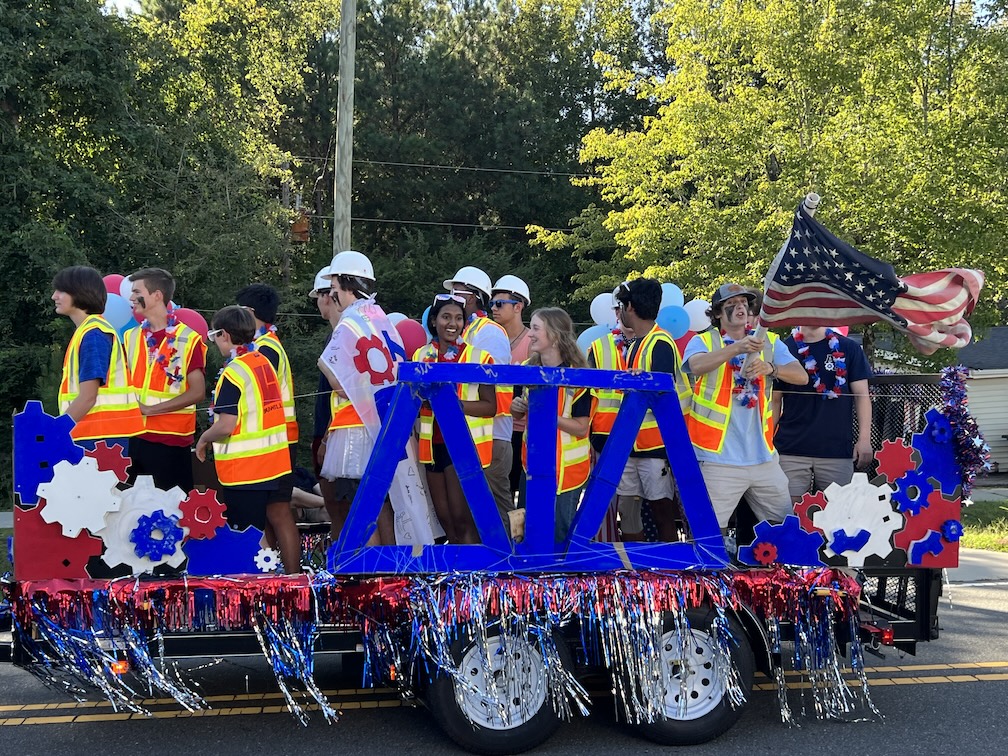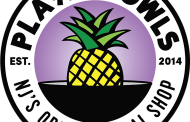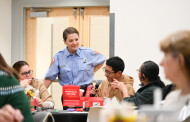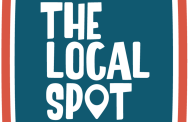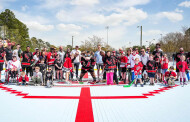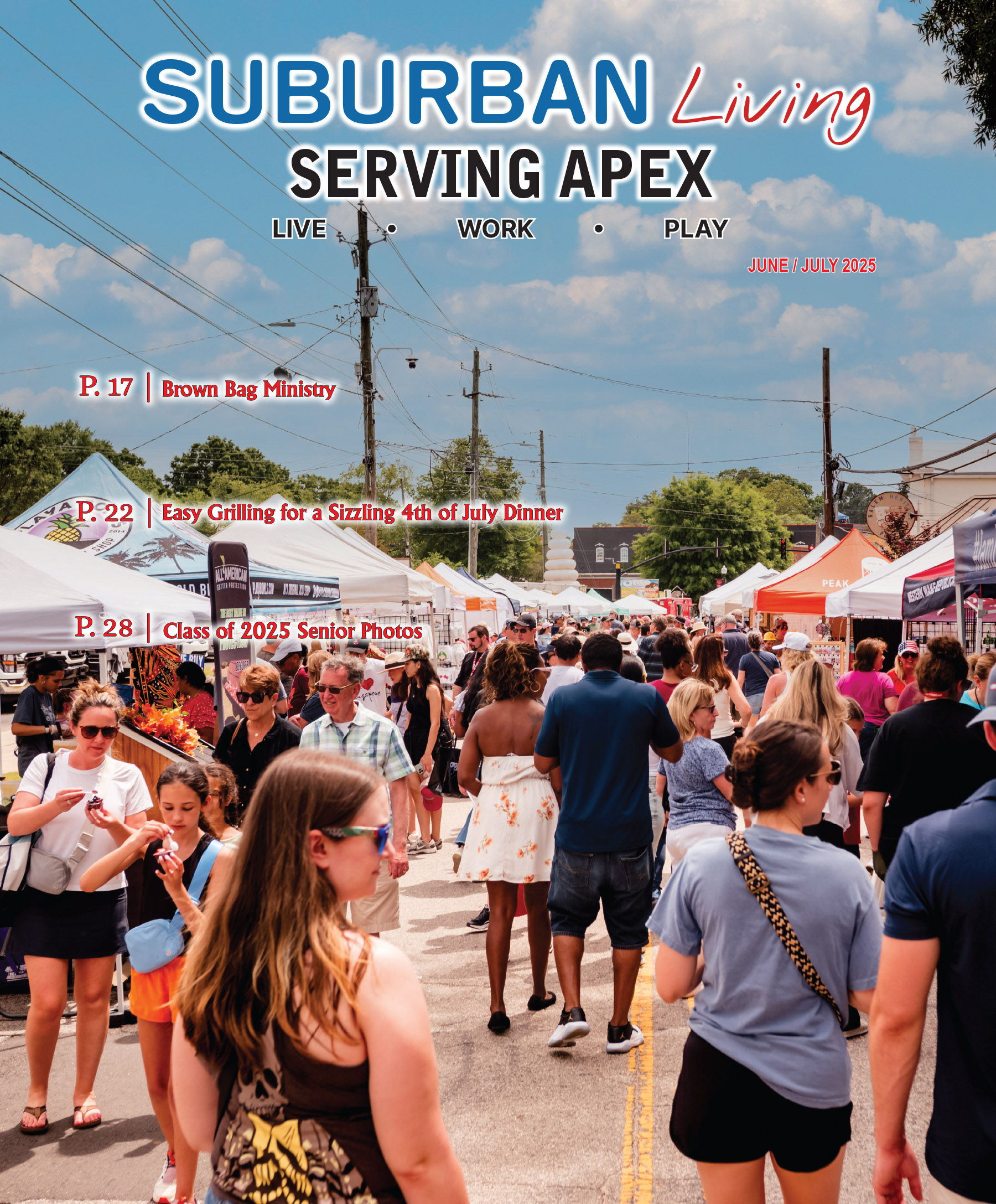As parents, we all want to give our children the best possible start in life—especially when it comes to life after high school. Some kids will go on to a four-year college and maybe even graduate school. Some kids will earn an associate’s degree or professional certificate from a community college or other accredited higher learning program. Some will dive straight into the job market. There is no right or wrong way, no good or bad way, since any path can lead to success and economic stability. What sometimes helps, however, is a little bit of extra preparation for and exposure to real life before actually sending them through that door. We are fortunate in Apex to have unique opportunities for our students, including attending a “school within a school” at Apex Friendship High School.
I recently sat down with Gretchen Krueger, director of the Apex Friendship High School Academy of Engineering & Advanced Manufacturing (A.O.E.), and two students, one current and one graduate, to learn more about the A.O.E. option at AFHS. I was curious about the program’s focus and benefits, and how students and community members can get involved if they’re interested.
According to the A.O.E. website: “The Academy of Engineering & Advanced Manufacturing is a small learning community within Apex Friendship High School. Designed as a four-year high school program, the Academy has an open and equitable student recruitment process that results in a student body that reflects the demographics of the school community.”
Royce Edward Watson, a college senior and former student of the Academy, is currently earning his degree in architectural engineering. In hindsight, he sees many advantages to having gone through the A.O.E. program.
“One of the major benefits that I found at A.O.E was having an internship experience before our senior year of high school. My college is very big on making sure that we have a career once we get out of school—leveraging that experience that I gained in high school and having an internship where I’m involved in the workforce at that early stage. Applying to internships in my freshman year of college, and showing people that I already have experience, was very beneficial.”
Royce continued by describing his college experience and how A.O.E. helped him.
“My program is actually more project based. A lot of the aspects of teamwork and communication that I learned in A.O.E. through our freshman year projects and our senior design project, I was able to incorporate into my [college] engineering courses as well. Currently, I’m in Senior Design I, which is our capstone project. We’re working with other departments in our school to work on a building that we’re constructing. I’m able to take what I learned from A.O.E.—technical skills in software, like SketchUp or Autodesk Inventor—and apply that to my current years in college as well.
John Kime, current A.O.E. student president, will be majoring in computer science with a minor in finance. He agreed with Royce, saying, “I think on the soft side, the teamwork skills and the communication skills from A.O.E. make the entire program versatile in any field. Students don’t necessarily always want to go into engineering, they may want to go into business or medicine, and those teamwork skills will always carry over. And the internship, paired with [those skills], help set up kids for a very broad future with enough qualifications to be good at what they will do.”
For Krueger, one added benefit is the fact that A.O.E. is a smaller learning community, called a cohort, within a large public high school. She explained, “The students come into three cohort-based classes out of four in freshman year. So, they really all get to know each other like a family. And they do a lot of cross-curricular projects, especially in the earlier years when there is a mixing of content within their classes. They not only are studying individual subjects, but they’re seeing how subjects can interrelate.”
She went on to say, “We also bring a lot of community members into their program to support their learning, so they can interact with adults. We’ll have experts in the field come in and evaluate [student] projects, give them feedback, and then [students] submit their final project so they are really interacting with adults a lot more than the average high school student.”
Community involvement is vitally important in programs like A.O.E. and Krueger explained the different ways the public can get involved, beginning with either a direct email to her or completing a survey that outlines various engagement activities.
“There are lots of different opportunities that range from just an hour of time for the entire year, to more involved. We’ll have parents or community members come in and do practice interviews with the students. They will review [student] resumes, give them feedback, review their projects, or judge a project as an expert. For a particular field that we’re studying, or a topic that relates to the curriculum of that class, we’ll bring in a guest speaker. Job shadow hosts—we always are looking for those—and that’s really just a three- to four-hour commitment for one day. Some people think of job shadowing as a large commitment, but you’re really committing to one day for three to four hours. Every student does an internship between junior and senior year, so we’re always looking for people in related fields.”
Both John and Royce had internships. John told me, “I did mine at UCB, which is a biopharmaceutical company out of Belgium—so not necessarily engineering. But it was some web design, some quality analysis, and just basically working in the pharmaceutical field. If parents or people in the community cannot necessarily donate their time, donating their connections or donating the knowledge is always very helpful.”
Royce shared that his internship was with LS3P, an architecture and planning firm in North Carolina. “I was working on a condominium project at the time,” he said. “I worked on concepts through SketchUp software, 3D modeling software, for a stairwell design and also looked at and analyzed 3D models for energy analysis through another program called Autodesk Revit, which is more of an information modeling program. It was pretty cool.”
I asked Krueger about the size of the program and the A.O.E. Expo coming up on February 21 at 5:30 p.m. She said, “We have 258 students that are in the elite program, out of 2800 students. The smaller learning community works for a lot of students. And we take 75 freshmen every year. Our current students put on [the Expo], which is our way to show rising ninth graders what our program is all about. People that have questions about joining A.O.E. can get all of their questions answered that day. We’ll have the ninth-grade corner that will have all of the ninth-grade projects. This year, they did bridge projects. Last year, they did earthquake towers. The ninth-grade team will talk about interrelated projects, and we’ll have some of our equipment set up, like our 3D printer, which people can use to create some kind of fun little trinkets.”
John added, “We have an internship section, and for seniors we have a Q&A board. We have a WIE (Women in Engineering) section and Women in Science.”
Women still represent less than 25% of the total workforce in STEM and Aleena Kollu, Class of 2024, is vice president of the A.O.E. student board and a woman in engineering. She shared this about her experience: “Through project-based learning, A.O.E. has taught me leadership, communication, and problem-solving skills that I can use to impact my community. We have an abundance of resources like laser engravers, CNC milling machines, and 3D printers, allowing students to learn and engage with industry equipment. A.O.E. prepares us for a future in engineering and success in the real world by providing internship and job shadowing opportunities!”
Krueger added that the Expo will feature information about the Technology Student Association as well. “It used to be that we had senior projects, but we reverse our curriculum, so those will not be quite ready yet. We’ll feature the internships that they’ve done, and we might have some of our 10th graders talk about the job shadowing opportunities that they will have just completed. We’ll have some students set up to do a question-and-answer session and we’ll do a formal presentation with some student speakers, for the parents, at the end of the night.”
She further explained that the Expo is designed to encourage eighth graders to come and ask questions of other students. “Our students sell the program better than anybody else. We want eighth graders to not be intimidated, but to be walking around and asking questions. It is for the rising ninth graders to decide [if the program is right for them].”
John summed up his experience by saying, “It’s not really the projects that people take out of the academy, it’s more the skills you learn that are supported by the projects. Whether that’s team building, or the process of designing something—coming up with it, failing, doing it again, failing again—that’s definitely what I take out of the Academy. Yes, the projects are fun, and they’re memorable, but the skills are what I’ll use in the future.”
When I asked Krueger what else she wanted Apex readers to know, she responded, “One of our challenges is that it is difficult for our students to get engineering internships. A lot of times, those will go to college students. When people in the community who have an engineering background, or anything in the STEM fields, can provide internships but are more prone to taking a college student with more experience, I would encourage them to think about taking one of our students as an intern. The feedback that we get [from business leaders] is that they are blown away and they want to come back for another intern! We want students to do internships to either solidify that that’s what they want to do, or show them that it’s something they don’t want to do anymore. We would like for them to have that exposure before they go to college.”
If you have an eighth grader who will attend Apex Friendship High School, or if you are a business leader interested in getting involved in this valuable option for Apex students, visit the Academy of Engineering & Advanced Manufacturing website: https://www.wcpss.net/Page/8435. You can learn more about the Society of Women Engineers at https://swe.org/. Questions can be directed to Gretchen Krueger, NBCT, via email: GKrueger@wcpss.net.

